Exposure / Double Exposure
Camera Austria, Graz
by Robin Waart
So the exhibition is about light and dark, the young visitor concluded, without much hesitation, while I noticed and pointed to the sunbeams and shadows touching a woman’s arms in Erich Lázár’s Julia, Wien (2000), one after the other. The woman in the picture is vacuuming a zebra skin carpet, almost kneeling, the metal rod behind her, holding the plastic nozzle in one hand, three fingers on the other about to stroke the dead animal’s fur. The black-and-white analogue photograph is taken slightly from above, in such a way her eyes, looking down, seem shut.
Unframed, but stuck between Camera Austria’s ornamented window frames, as if the gaps between the windows had been exactly made for them, the photograph was one of five gelatin silver prints by Lázár in Exposure – replaced eight weeks later for Double Exposure by a much larger and framed C-print that Georg Petermichl took from his family’s photo album: a picture of a picture originally shot by the artist’s mother, reshot by her son, Gertraud Petermichl: Ärger über den gefällten Baum (Universal Thoughts), 2002/2023. Half in front of the window, the other half leaning against the wall, the placement of the frame, somewhat off the grid, aligns with its content, matted by a white border on one side and the cropped corners of other family photos beside it, because this is how they appear in the image’s source.
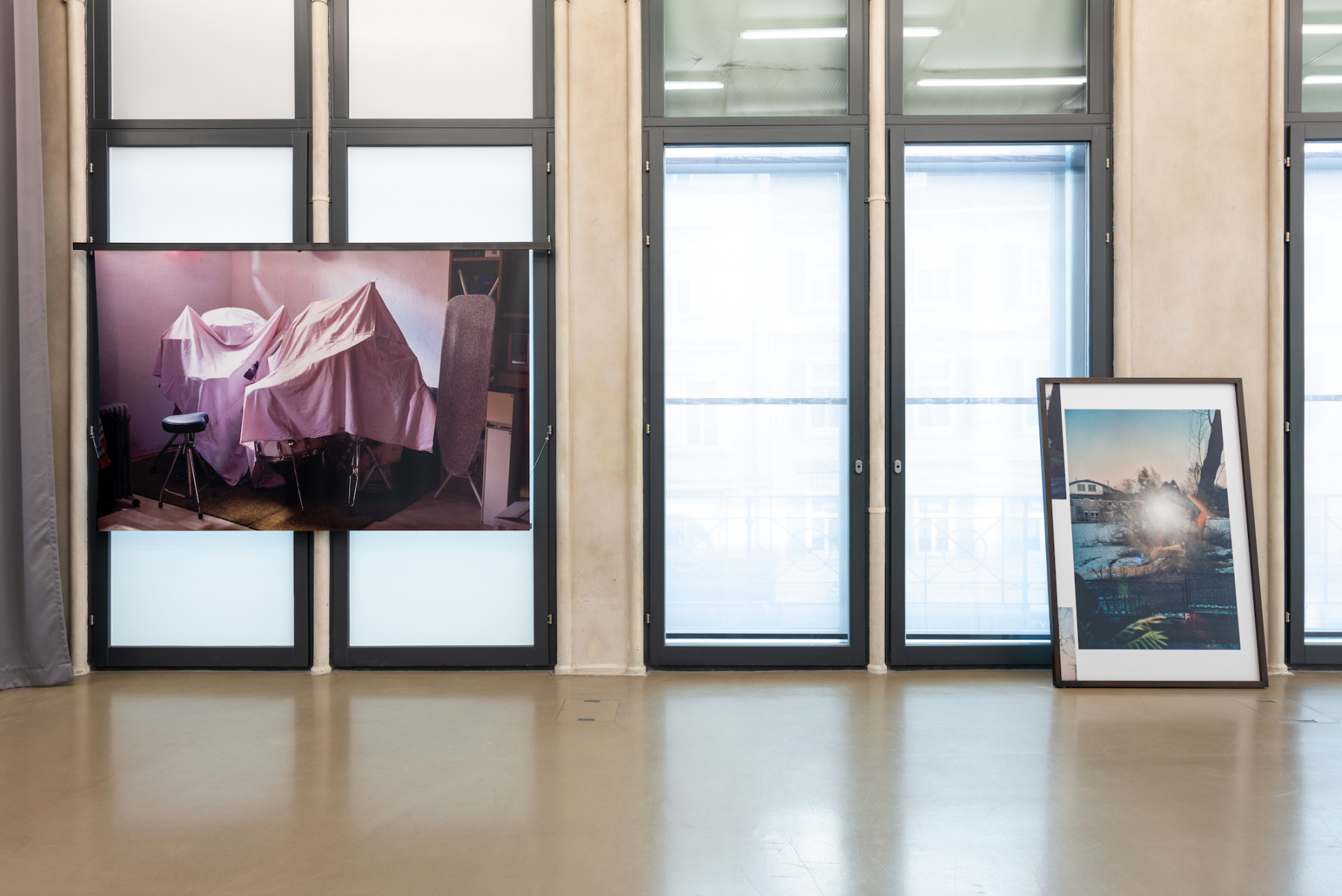
Double Exposure, Camera Austria 2023, Georg Petermichl, Universal Thoughts: Petrified 2009/2023 and Universal Thoughts: Gertraud Petermichl: Ärger über den gefällten Baum, 2002/2023. Photo by Markus Krottendorfer.
The first and second chapter of the exhibition series Fields of Focus [1] by newly appointed curator Anna Voswinckel, Exposure / Double Exposure can be seen as a reappraisal and redirection of Camera Austria, the exhibition space, the institution and the medium it focuses on, conscious of the past and future, by zooming in on what photography can perhaps do better: breaking down the distance, between then and now, here and there, them and us.
Attuned to these relationships in time and space both intentionally and intuitively, the works in the show(s) interlock, connected between each of the two installments (or versions) by the question what it means to redo, revisit, revise what seems a fixed position – and proposing, instead, a glorious refusal to leave things as they are.
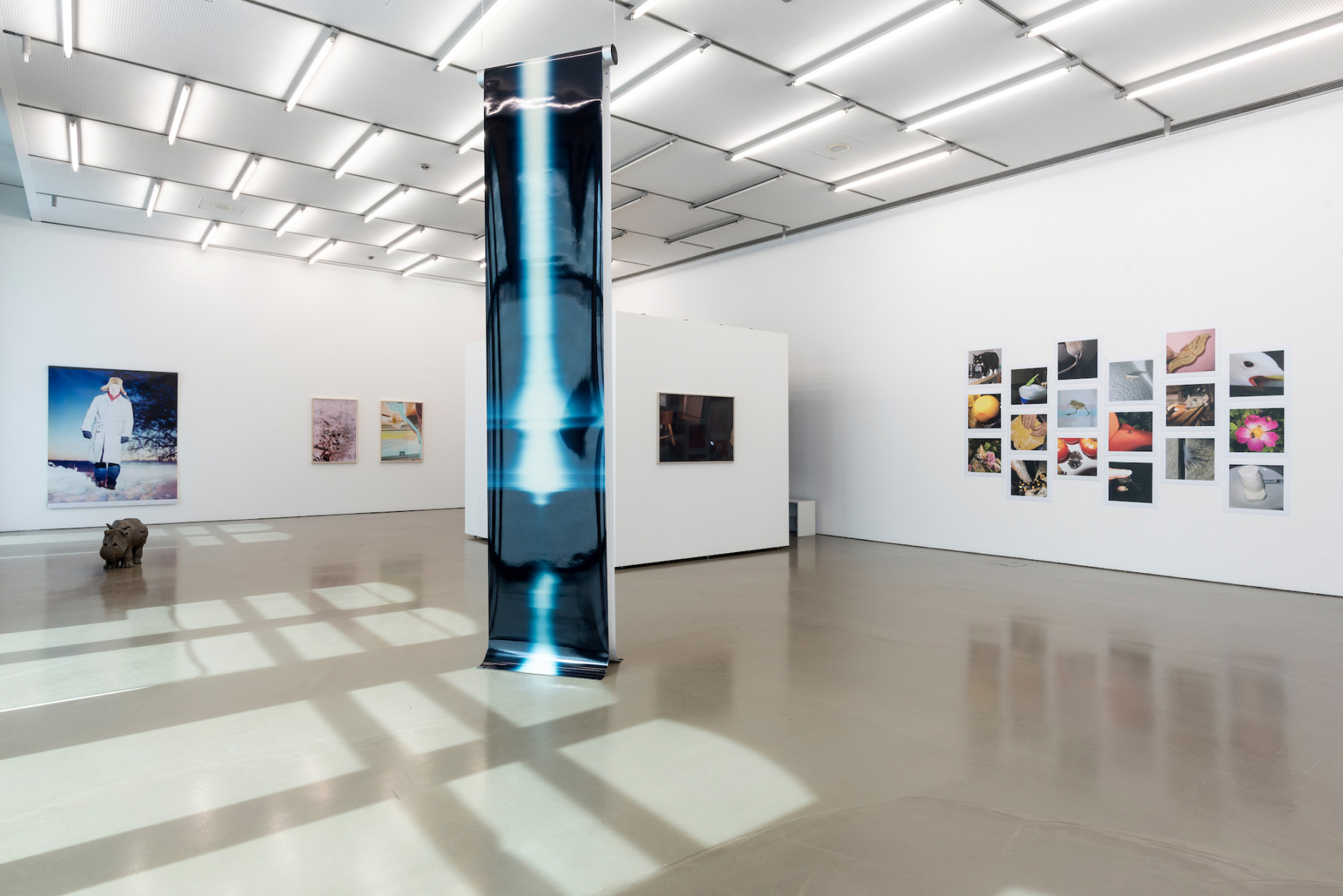
Exposure, Camera Austria 2023, Georg Petermichl, Lisa Holzer, Stefanie Seufert, Niklas Taleb, Manfred Willmann. Photo by Markus Krottendorfer.
The result responds to the exhibition space itself, not just the walls, but its nooks, corners, windows and the spaces inbetween. Setting this tone, Sophie Meuresch’s Treppe (2022) is aptly placed outside the exhibition space, a photo of stairs by the stairs; as if the flash on the balustrade inside the image were caused by the bright spotlights shining onto it on site, opposing a literalization of the subject, because the mirroring works two ways.
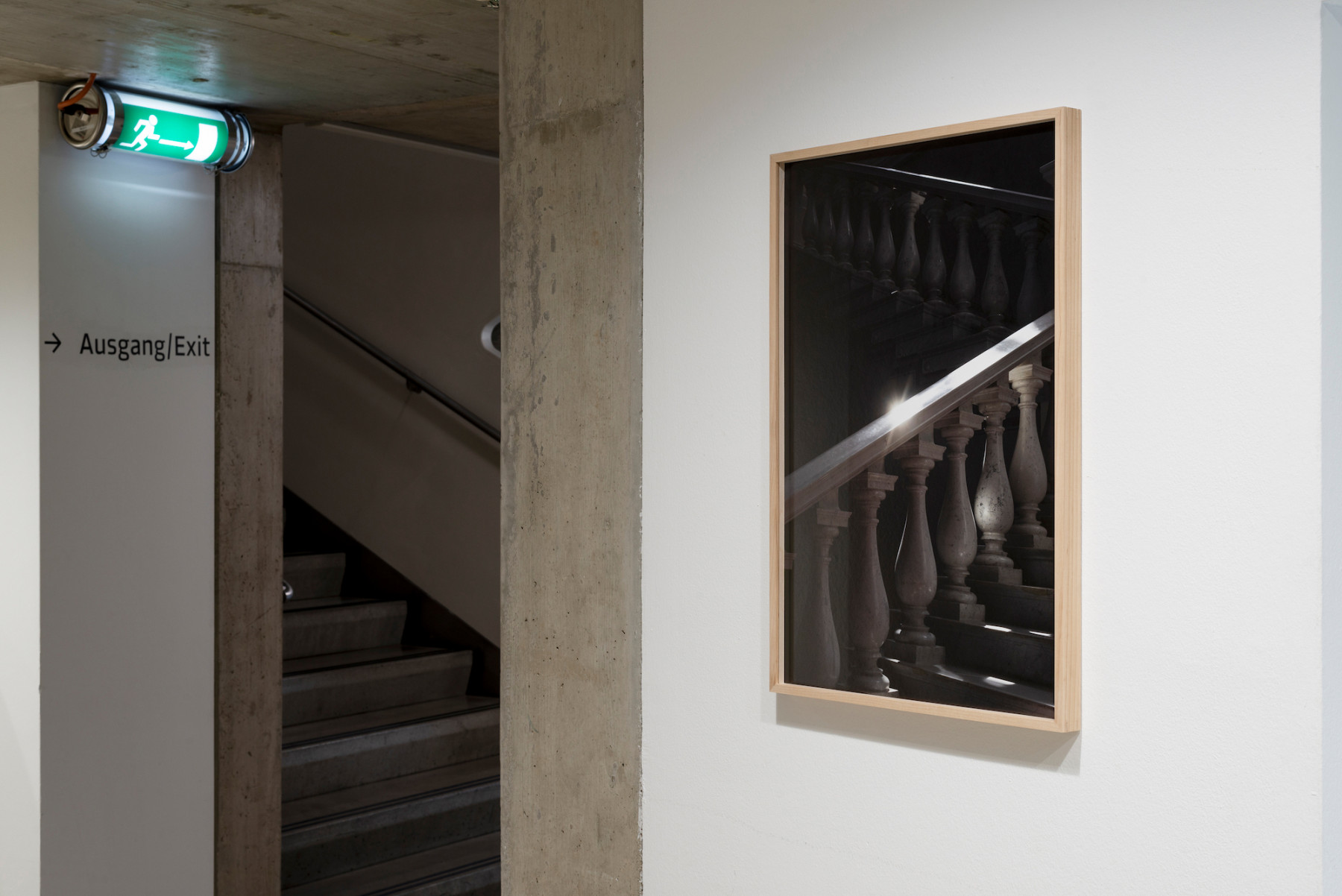
Exposure / Double Exposure, Camera Austria 2023, Sophie Meuresch, Treppe (Reflexion), 2022.
But the response also comes in the form of acknowledgment and negotiation, toward the small institution’s history as an artist run platform, by incorporating Lázár, Manfred Willmann and Seiichi Furuya as a first league of international Austrian photographers and founders of the magazine-and-space that Camera Austria is. In the second of the two shows, their positions are, quite literally, overlaid by a younger generation’s work. Furuya’s five views from his Vienna window (Soweit das Auge reicht, Wien 1983-1984)[2] – pictures that seem to both look out and trapped inside a room – are replaced in Double Exposure by an experimental colour photogram by Stefanie Seufert (o.T. grün, 2023) and two of Sara-Lena Maierhofer’s motion studies.
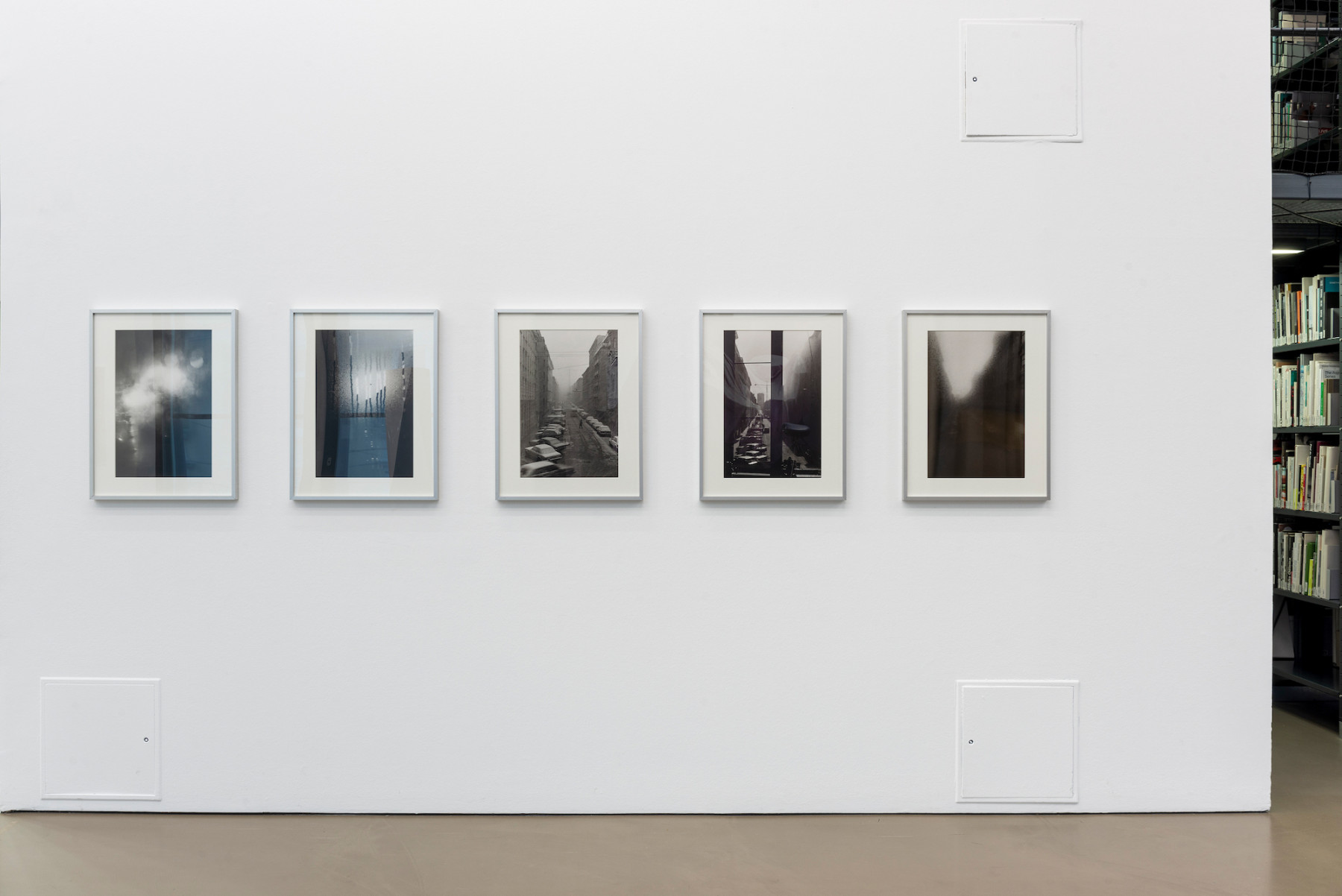
Exposure, Camera Austria 2023, Seiichi Furuya, from So weit das Auge reicht, Wien 1983–1984. Photo by Markus Krottendorfer.
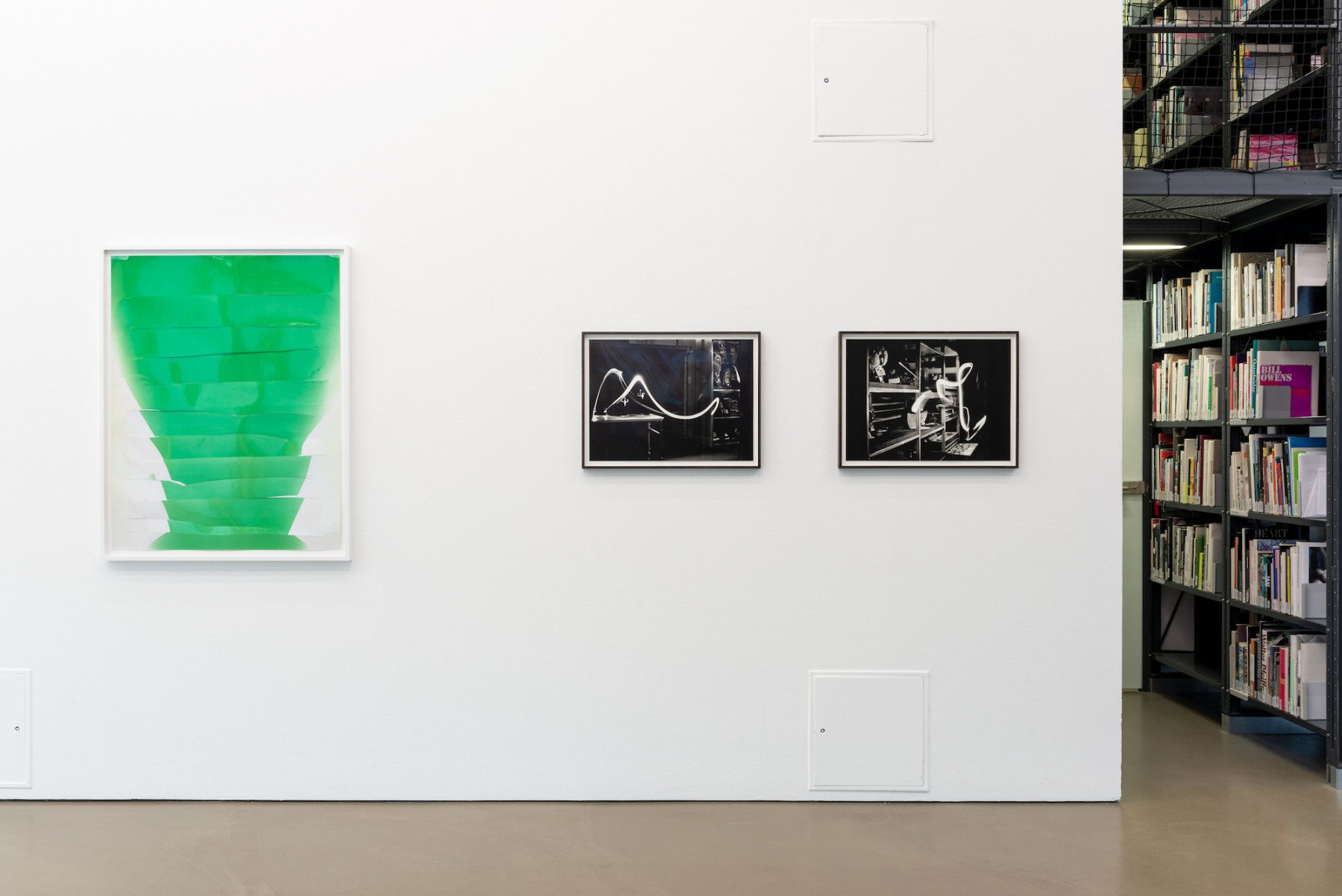
Double Exposure, Camera Austria 2023, Stefanie Seufert, Sara-Lena Maierhofer. Photo by Markus Krottendorfer.
The swirls of flashlight in Maierhofer’s photos, illuminate the storage shelves of an ethnological museum, to reveal a collection of diasporic masks and objects (Bewegungsstudie 1 and 14, 2020). Taking position right next to Camera Austria’s own archive, the flashes pick up the purple highlighted fragments in Seufert’s photos, from a text by Marguerite Duras about the impossibility of seeing and recognising oneself through photography, present in both Exposure and Double Exposure. These decolonial and written excerpts then lead into what is more personally political, in the center of the space, in Double Exposure: a catwalk with 500 candle holders made of scrap metal and bric-a-brac by Rebekka Bauer’s grandfather after WWII. In Bauer’s installation Die Aufstellung (2020/2023), the homemade candelabras are juxtaposed with enlarged black and white prints from her grandfather’s National Socialist years and small family photos, snapshots in different sizes, colours and qualities, on the outer and inner of the building’s double windows: with a generation’s distance between them.
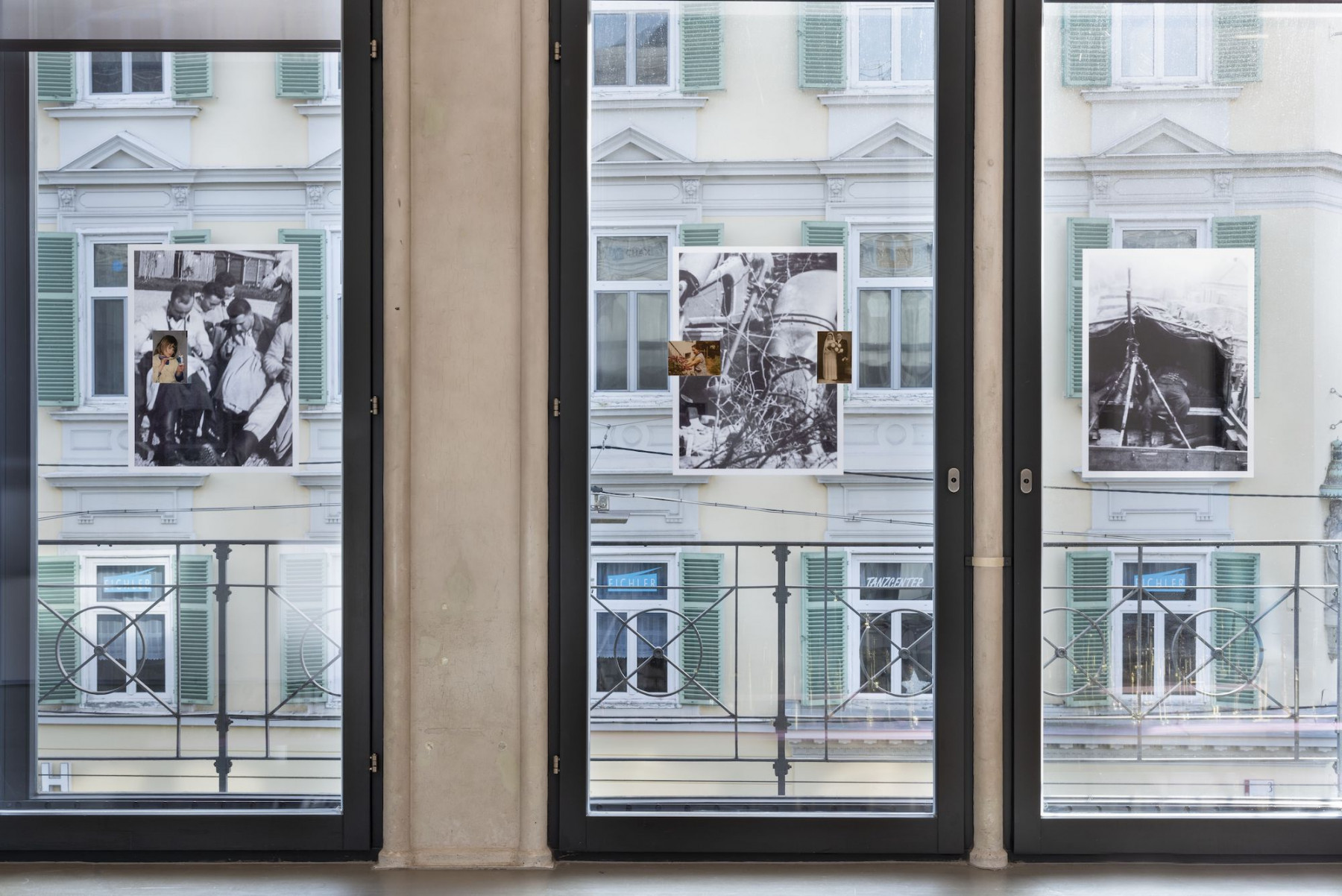
Double Exposure, Camera Austria 2023, Rebekka Bauer, from Die Aufstellung (The constellation), 2020/2023. Photo by Markus Krottendorfer.
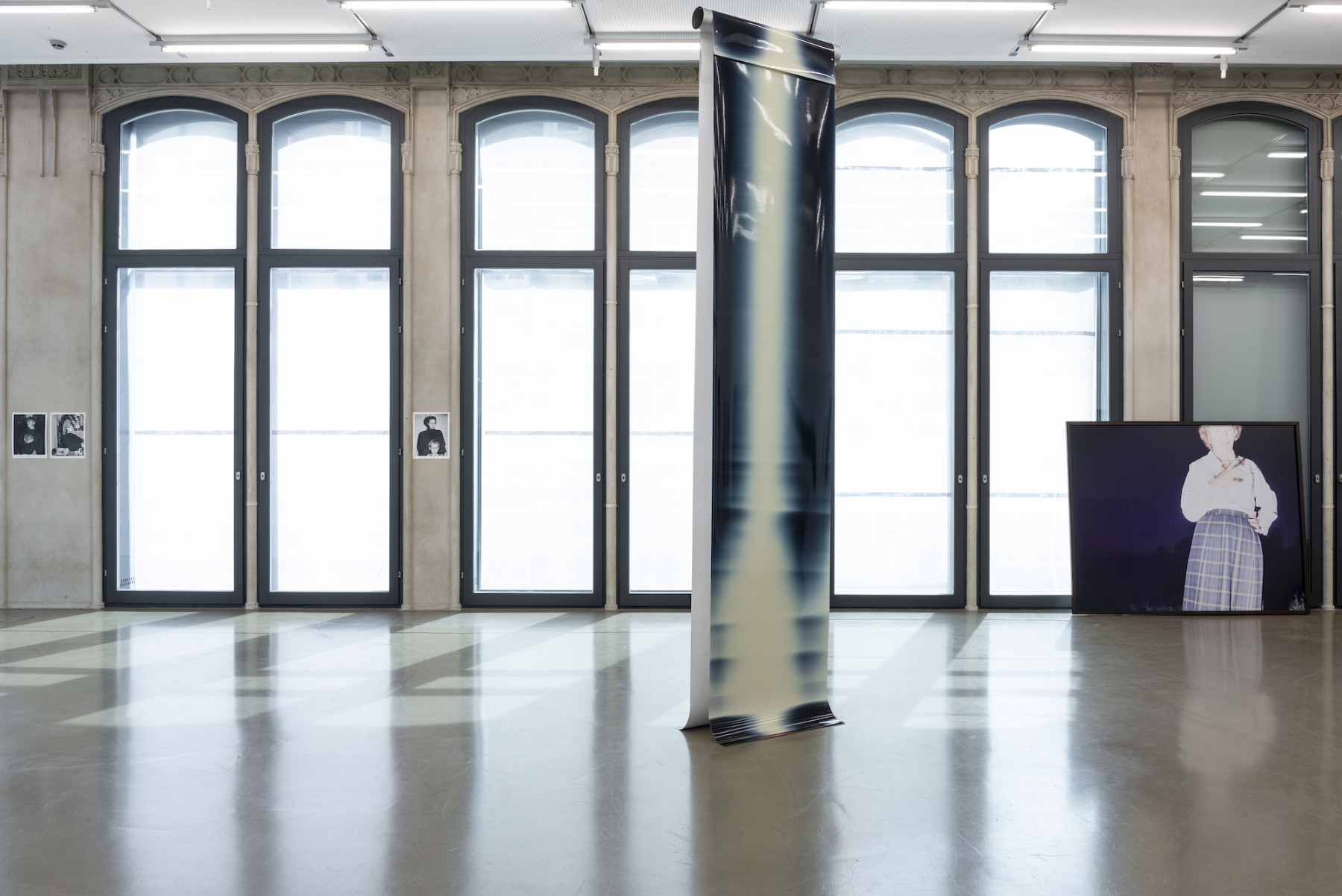
Exposure, Camera Austria 2023, Erich Lázár, Stefanie Seufert, Georg Petermichl. Photo by Markus Krottendorfer.
Such superimpositions and recombinations appear not just between the shows and among the works, they are also embedded inside each of them, as positions and relationships (on time, across time and generations) with a palimpsestic quality. Straightforwardly when Oliver Husain and Kerstin Schroedinger place a screen in front of a screen, a 16mm projection overcasting a digital video in DNCB (2021), their research project about the experimental use of a colour developing liquid as an alternative aids cure in the 1980s, with several side effects. Poetically and almost invisibly in Sim Chi Yin’s lightboxes with lantern slides made to advertise the British Malaya colony, with images of her disappeared grandfather and child grafted into them (The Suitcase Is a Little Bit Rotten, 2023). Another, referential aspect comes through as critical homage in Georg Petermichl’s Universal Thoughts (After Kühn 3, 2009/2023), with his father and two sisters looking up at their mother, an image that restages his own family into a matriarchal structure in the style of Heinrich Kühn’s portraits of his children [3]. Separated in Exposure, next to each other in Double Exposure, Lisa Holzer’s photos of her and her son’s shared iPad, their fingerprints everywhere but indistinguishable, are succinctly titled Family (2023).
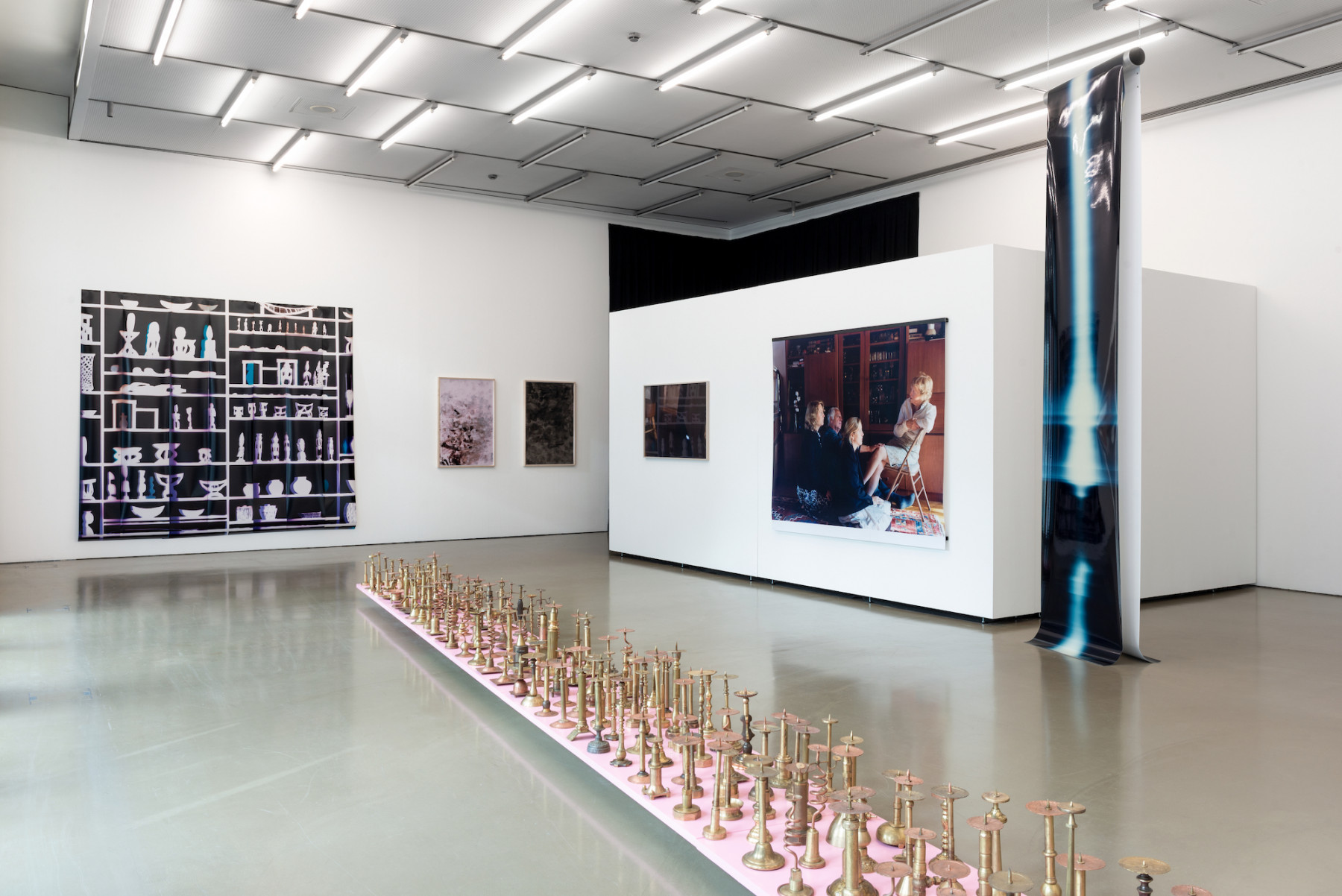
Double Exposure, Camera Austria 2023, Rebekka Bauer, Sara-Lena Maierhofer, Lisa Holzer, Niklas Taleb, Georg Petermichl, Stefanie Seufert. Photo by Markus Krottendorfer.
Here, the “tenous umbilical cord”, mentioned in the curatorial statement [4], that for Barthes [5] connects the photographic image and its referent – something of a direct line between the photo and its object or its source – is a metaphor worth looking at again, to be taken more literally and more seriously. In Anna Voswinckel’s proposed reading the cord itself extends to the subjects (the photographer’s or viewer’s) relation to and reception of it. Yet, as often as the works in Exposure / Double Exposure start from and return to an investigation of family ties, between generations, roles and places, the two exhibitions themselves too, are inextricably intertwined. Oscillating between displacement and replacement, what stays and what goes away:
– Flo Maak’s cricket like a fly on the wall (Ohne Titel, 2023), unmoved;
– two out of seven prints from Niklas Taleb’s photo series Dream again of a better Generationenvertrag, Psychologie and Ohne Titel (Hannover), a kitchen obscured by darkness except for a dishwasher light, betraying its vicarious activity; a family friend posing in front of the Viên Giác Pagoda in Hannover (both 2020);
– the wooden mask in one of Erich Lázár’s photos in the first show resurfacing as kind of a translation in the second: on Sara-Lena Maierhofer’s shelf photograms, remaking a part of the Rautenstrauch-Joest-Museum’s ethnographic archive.
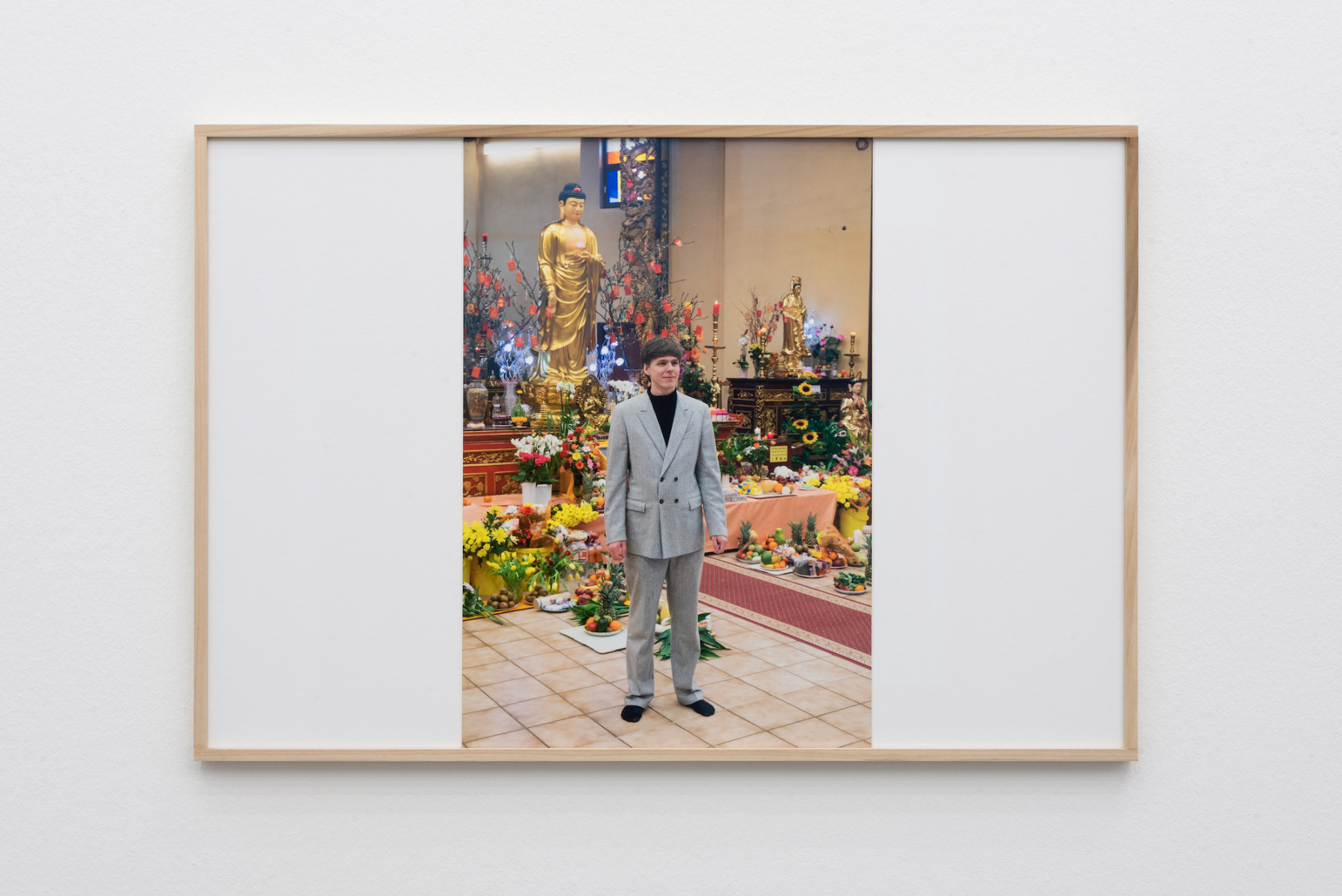
Exposure / Double Exposure, Camera Austria 2023, Niklas Taleb, from Dream Again of Better Generationenvertrag, 2020. Photo by Markus Krottendorfer.
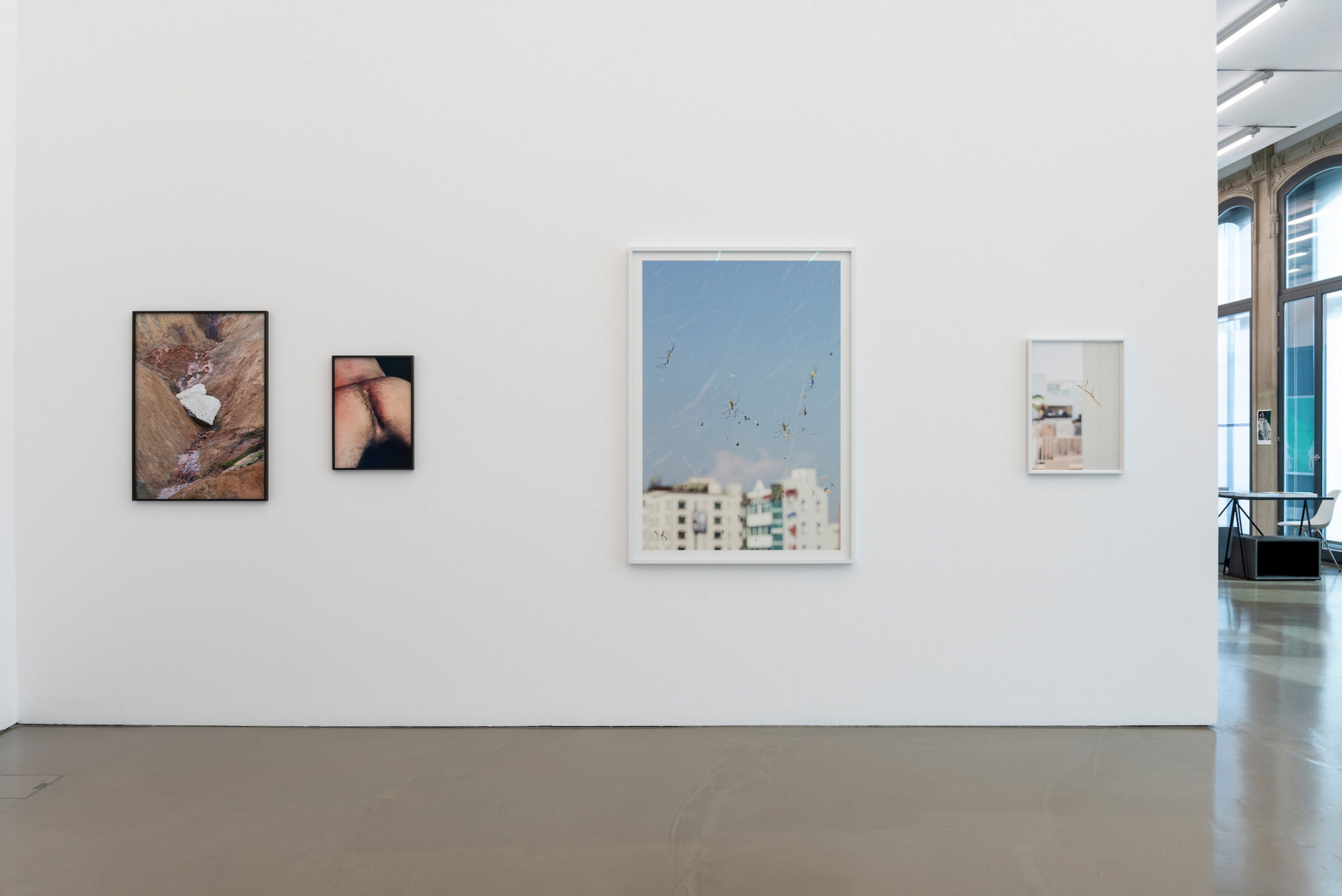
Exposure, Camera Austria 2023. Flo Maak, Tongue, 2023; ohne Titel, 2021; Descent, 2016; ohne Titel, 2023; Erich Lázár, Julia, Wien, 2000, from Private Eye, 1982–2000. Photo by Markus Krottendorfer.
And the zebra carpet, the image that the young visitor and I talked about, between dark and light – a Ukrainian refugee, it turned out, now living in Graz, speaking ominous words so hopefully. This image from Exposure, no longer present in the second show except as a memory, a remnant or reminiscence that in the extended context (of Double Exposure) changes from personal and private to colonial, polemic – but also a testimony to the stories, places, moments of intimacy and immediacy that photographs can hold onto for us — maybe not always better than other media, but at least trying to do so.
Not as black and white as he made it, it is as if the question of what these photographs share is about seeing photography as a family secret. This is why some photos need to be looked at again and again, in the album, the archive and against themselves. One way to do so is when the exhibition asks us to come back, look and think back, to their previous reasons, life, reprogramming our experience of them. Under a new light, saying: don’t get too used to things as you think you know them. The referent is taken out of the photograph and put back, not where it belongs, as if it ever belonged anywhere, but ready, for new relationships, to move.
[1] “The group exhibition Exposure will be kicking off the curatorial project Fields of Focus, which investigates photographic practices within contemporary art in their respective social and political contexts. Serving as a point of departure are the terms exposure, reproduction, and transfer.” Exposure, Intro on camera-austria.at.
[2] Seiichi Furuya’s photos themselves are a view on the tradition of painting as a window of which Niépce's first, unclear heliograph photograph, View from the window at Le Gras (1826–27), currently in the collection of the Harry Ransom Center, Austin.
[3] The Austrian-German photographer Carl Christian Heinrich Kühn (1866-1944), a pioneer of the the color autochrome technique, who used his four children and their governess as models for his idealised impressionistic experiments in portraiture. Cf. Das bedrohte Paradies. Heinrich Kühn fotografiert in Farbe (eds. Leo Andergassen, Sabine Schwienbacher). Tirol: Südtiroler Landesmuseum für Kultur- und Landesgeschichte, Schloss Tirol 2014
[4] Exposure, Intro, Read more on camera-austria.at.
[5] “It is by this tenuous umbilical cord that the photographer gives life”, Roland Barthes (translated by Richard Howard), Camera Lucida. New York: Hill and Wang 1981, p. 110.
[6] Moritz Scheper has written about these photographs of Niklas Taleb’s both touching- and convincingly in ‘Ausserordentliche Freiheiten’, Texte zur Kunst, 21 August 2020.

Exposure, Camera Austria 2023, Erich Lázár, Julia, Wien, 2000, from Private Eye, 1982–2000. Photo by Markus Krottendorfer.
Exposure / Double Exposure
16.09. – 12.11.2023 / 25.11.2023 – 28.1.2024
With works by Laurence Bonvin, Seiichi Furuya, Lisa Holzer, Erich Lázár, Flo Maak, Sophie Meuresch, Georg Petermichl, Stefanie Seufert, Niklas Taleb, Manfred Willmann
/
With works by Rebekka Bauer, Oliver Husain & Kerstin Schroedinger, Sara-Lena Maierhofer, Sim Chi Yin, and: Lisa Holzer, Flo Maak, Sophie Meuresch, Georg Petermichl, Stefanie Seufert, Niklas Taleb
02.02.2024 Artist Talk with Sara-Lena Maierhofer and Belinda Kazeem-Kamiński
Camera Austria, Graz
Lendkai 1
8020 Graz
Austria